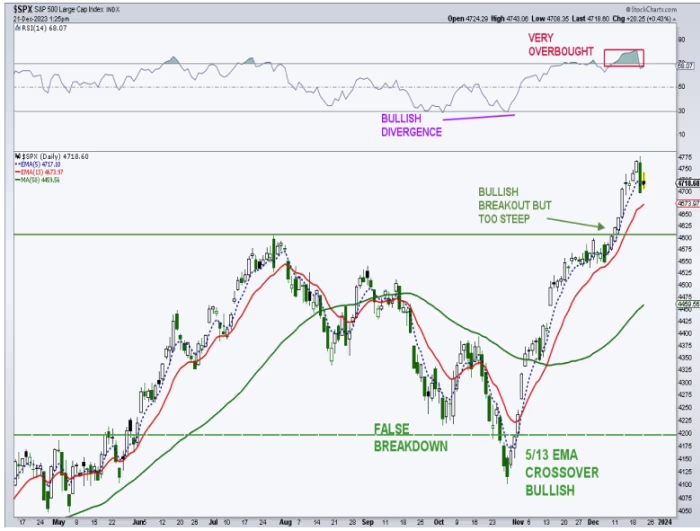U.S. stocks faced a clear risk of a technical pullback following a rapid surge from October lows. However, Wednesday’s abrupt downturn on Wall Street has prompted traders and analysts to contemplate whether more challenges lie ahead.
Analyzing numerous charts, technical analyst Mark Arbeter, President of Arbeter Investments, observed, “Some Technology stocks are extremely extended, and many of 2023’s previously lagging stocks have also experienced significant extensions after substantial recoveries. This leaves few attractive charts, at least in the near term,” as stated in a note on Thursday.
Arbeter added, “So, this was either a one-day wonder or the start of a decent pullback.”
On Wednesday, the Dow Jones Industrial Average (DJIA) plummeted 475.92 points, or 1.3%, marking its most substantial one-day percentage drop since October 3. This concluded a five-day streak of record highs. The S&P 500 (SPX), which had approached its January 3, 2022, record close, retreated 1.5%, closing just below 4,700—the most substantial percentage decline since September 26. Meanwhile, the Nasdaq Composite (COMP) experienced a 1.5% drop, the largest since October 26.
Despite Thursday’s partial recovery in all three major indexes, Arbeter identified trendline support for the S&P 500 at 4,675, with the rising 21-day exponential moving average at 4,621. He emphasized the importance of 4,600 as a crucial chart support level, as it marked the beginning of the last upside breakout.

The Dow and Nasdaq had both rallied for nine consecutive days before Wednesday’s setback. While the surge had made major indexes considerably overbought based on technical indicators, Arbeter noted that not all signs pointed downward. Price momentum and market breadth were extremely overbought, but daily bearish momentum divergences were absent, and breadth remained strong.
Arbeter highlighted that the percentage of S&P 500 stocks above their 50-day moving average had spiked to 91%, while the Nasdaq-100-tracking Invesco Trust QQQ Series ETF (QQQ) saw a 95% reading on December 19.
Referring to historical data since the end of 2001, Arbeter mentioned that such “breadth thrusts” typically occur in the early or middle stages of a bull market, with a cautionary note on the exceptions in October 2007 and January 2018. Despite the likelihood of a near-term pullback, Arbeter expressed optimism about the bull market’s potential to continue based on price and breadth indicators.




